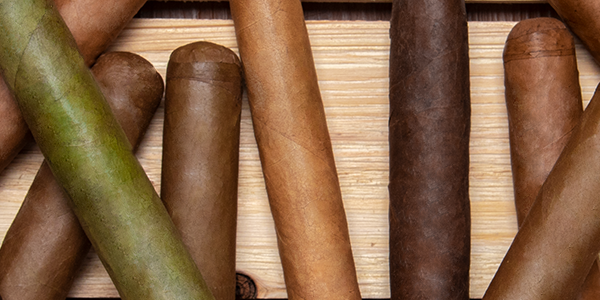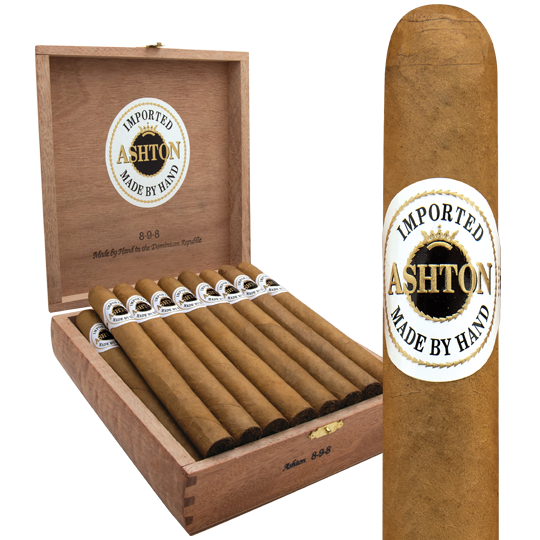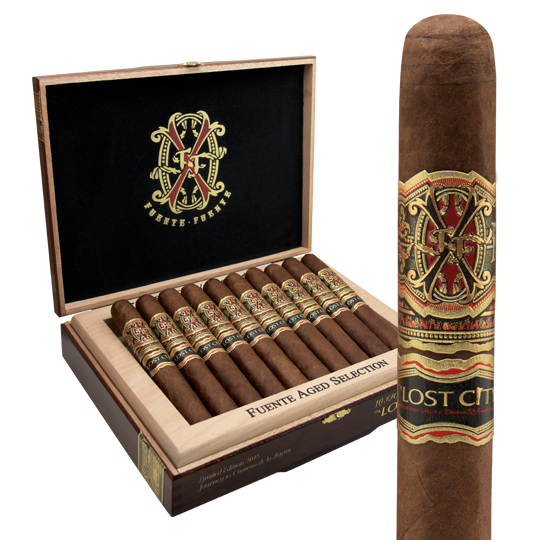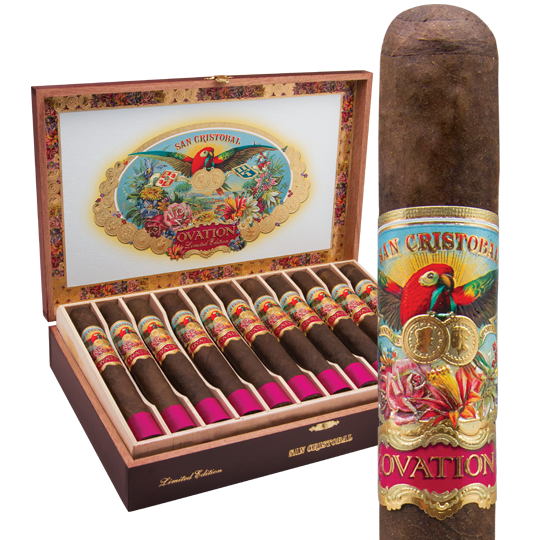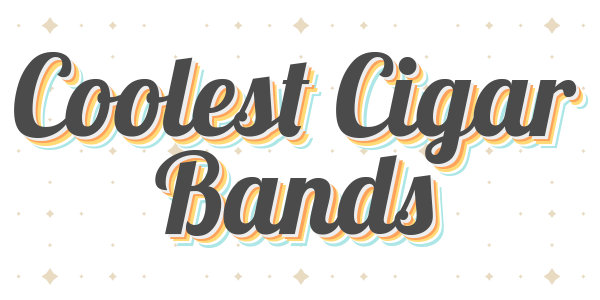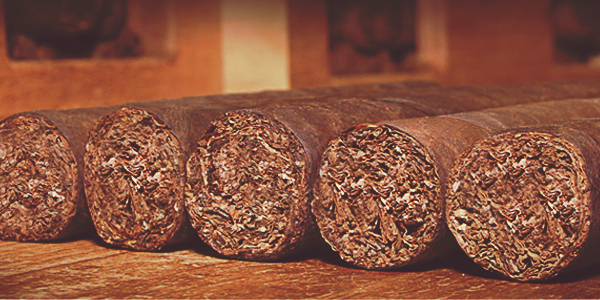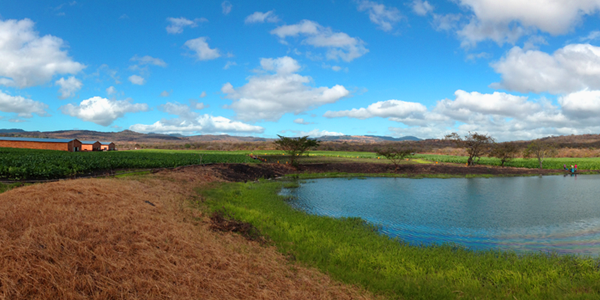Guide to Cigar Wrappers & Colors
There’s more to a wrapper than meets the eye. The first things we notice about a premium handmade cigar are its band and its wrapper leaf. The way a cigar looks entices us to buy it or leave it on the shelf. Cigar-makers fixate on a cigar’s color, texture, and taste when they create a blend. The wrapper plays a huge role. The wrapper is the most expensive part of a cigar because it must look perfect, and it can represent sixty to eighty percent of the flavor we perceive. Cigar-makers are especially picky when choosing the wrapper for a blend. Here’s an overview of cigar wrappers and how they are classified.
What Makes a Great Wrapper Leaf?
An ideal wrapper leaf is visually pristine, not too veiny or rough in texture. While coarser tobaccos are well-suited to deliver flavor and body, the thick, visible veins they display make these leaves less desirable as wrappers. Additionally, a patient and proper fermentation of the tobacco ensures the wrapper exhibits a blemish-free, consistent color. Wrapper leaves are often harvested from the middle section of a tobacco plant, also called Seco.
A number of terms are used to define the most common types of cigar wrappers used today. Some of these terms pertain to color, country of origin (where the leaf is grown), and seed varietal, while other terms represent a blend of these elements. Becoming familiar with the types of wrappers today’s cigar-makers grow can be essential to understanding why you prefer certain cigars over others. We’ve compiled a detailed Wrapper Glossary below that identifies a number of terms that characterize today’s cigar wrappers.
Before we jump into the glossary, let’s begin with two of the broadest categories for classifying wrappers: Natural and Maduro. In a general interpretation, Natural and Maduro are akin to light and dark. While both Natural and Maduro encompass a number of more specific wrapper types, they identify a basic, easy-to-see classification that can be applied to a wealth of cigars. When a cigar blend is offered in both a Natural and a Maduro wrapper, the Natural is typically milder and nuttier by contrast, while the Maduro delivers a sweeter, earthier taste.
Natural Wrappers
The most common types of Natural wrappers are Connecticut (or Connecticut Shade) and Ecuador Connecticut. The best Connecticut cigars are light-tan or golden-blond in color. Think of Ashton Classic or San Cristobal Elegancia. Tasting notes of almonds, cashews, cedar, and buttered toast with mild to moderate spices are common in many popular Natural cigars, especially those rolled with an authentic Connecticut wrapper.
A number of brands, retailers, and consumers use Natural as a blanket term to describe a host of wrapper types – essentially, any wrapper that is not a Maduro. Therefore, you may encounter Natural as a broader definition for other wrappers outlined below (i.e. Ecuador Habano, Nicaraguan, Corojo, and more).
Occasionally, you may hear Natural wrappers referred to as “English Market Selection,” however this is simply a quality designation for Cuban cigars sold in the UK market. You’ll rarely hear it used in the U.S.
Maduro Wrappers
Maduro technically refers to a fermentation process (how the wrapper leaf is aged). Maduro wrappers undergo a meticulous natural fermentation to achieve varying degrees of the lustrous, dark brown color and rich, often sweet, flavor for which they’re known. Maduro wrappers can exhibit a very dark brown or even jet-black color. Ashton Aged Maduro is a popular, well-known example of one of today's best Connecticut Broadleaf cigars.
Maduro translates to “mature” or “ripe” and is a wrapper type not specific to any one country, region, strength level, or flavor profile. Although numerous Maduros are available today, roughly 40 years ago, Maduro cigars did not exist. Maduro wrappers emerged as consumer tastes evolved with preferences for added complexity, flavor and richness. Cigar-makers embraced creative methods for processing and fermenting tobacco to satisfy the growing sophistication of consumer tastes.
Maduro wrappers originate from a number of seed varietals and can be grown in many countries and key tobacco-growing regions around the world. Prized for its quality and flavor, Connecticut Broadleaf is the best-known Maduro variety.
Maduro wrappers can be further classified by their color. A Colorado Maduro wrapper exhibits a dark brown shade that falls in a lighter spectrum. Oscuro wrappers, sometimes called Double Maduro, are nearly black in color and refer to the darkest, most lustrous leaves. A combination of crucial factors, including the amount of sunlight a plant receives, the area of the plant from where the leaf is selected, and the duration and temperature of the fermentation process impact the resulting color, flavor, and strength of a wrapper. Maduro cigars can be mild, medium, or strong.
Following is our Wrapper Glossary. Beyond the basic understanding of Natural and Maduro cigars, we’ve outlined a number of terms that identify important details, including region or country of origin, fermentation processes, and seed varietals, as they pertain to many popular wrapper leaves today.
Wrapper Glossary
Brazilian
Brazilian wrappers typically exhibit a dark, almost jet-black shade that looks a touch dry, at first. Astringent coffee bean and black pepper notes with a bit of sweetness are common. Popular blends handmade with a Brazilian wrapper leaf include CAO Brazilia and La Flor Dominicana La Nox. Brazilian cigars are less common than other wrapper varietals, but they occupy an important niche.
Cameroon
Cameroon wrappers are grown in the African nation of Cameroon, as well as the neighboring Central African Republic. They are prized for lush, approachable flavors that offer a wonderful balance of natural sweetness and spice. Arturo Fuente Hemingway and Arturo Fuente Don Carlos are two of the best-known and top-selling cigars handmade with authentic Cameroon wrappers. These leaves are distinct for their delicate, somewhat dry textures and a light to medium-brown appearance. Growing tobacco in Cameroon has long accompanied challenging circumstances due to the region’s decades of political unrest. However, the area’s rich soils yield unparalleled, unique flavors both new and seasoned cigar lovers appreciate.
Candela
Cigars rolled with a Candela wrapper are easy to distinguish due to the unmistakable green color of this leaf. Before the tobacco plant has fully matured, the leaves are harvested and dried quickly to lock in the plant’s natural chlorophyll content. As a result, Candela wrappers exhibit a noticeable green hue. Although less common than other wrappers, Candela cigars offer complex, grassy flavors of green tea and cedar with a hint of pepper and a lush aroma that is often mild and approachable. Argyle Candela, Don Lina Casa Verde, and Rocky Patel Mulligans Fairway Edition are all inexpensive bundles that deliver a marvelous introduction to this unusual and underrated leaf.
Connecticut
“Connecticut” refers to the Connecticut River Valley (a key tobacco-producing region in the Northeast) rather than the state. The Connecticut River Valley runs north from Harford, Connecticut, through the middle of Massachusetts and up through the shared border of Vermont and New Hampshire.
A number of the world’s bestselling, most iconic cigars are rolled with a Connecticut wrapper leaf, including numerous selections from Ashton, Arturo Fuente, Montecristo, and Macanudo. The fertile soils of the Connecticut River Valley produce exceptional tobacco crops unlike any other region. Connecticut wrappers are most closely associated with a light, golden-brown color, however, the term “Connecticut” encompasses a handful of very distinct wrapper varietals grown in the region, most notably: Shade and Broadleaf. Although the valley’s climate is limited to a shorter growing season, its tobacco crops are prized for their naturally sweet, creamy and succulent flavors. Because the sunlight is far less intense in the Connecticut River Valley than in many tobacco-growing regions along the equator, the resulting crops deliver approachable, elegant, and rich tobaccos.
Connecticut Broadleaf
Connecticut Broadleaf is the best-known Maduro wrapper. It is a medium to dark-brown espresso color and can even be nearly black. It is grown under direct sunlight and is often oily and sweet. Once considered a rough-and-tumble alternative to its more elegant cousin, Connecticut Shade, Broadleaf is a feisty, labor-intensive plant that dresses a number of celebrated smokes with tantalizing flavor and aroma, including Ashton Aged Maduro, Arturo Fuente Hemingway Maduro, and Rocky Patel Vintage 1990.
Tobaccos from a number of growing regions can be fermented into glistening Maduro wrappers, however, it’s impossible to duplicate the authentic sweetness of a true Connecticut Broadleaf. Notes of cedar, raisins, dark chocolate, black currant, licorice, chestnuts, and spices are hallmarks of the best Connecticut Broadleaf wrappers.
Connecticut Habano
Connecticut Habano is a less common wrapper. The term refers to Cuban-seed (Habano) tobaccos grown in the Connecticut River Valley. The use of Cuban-seeds in other regions has been prevalent for decades. Many of Cuba’s best cigar-makers fled the island in the years following Castro’s revolution and with them they smuggled out precious tobacco seeds for the chance to pursue their craft in other nations.
Today, Cuban-seed tobaccos are most commonly grown in Ecuador, otherwise known as Ecuador Habano. In recent years, a handful of cigar-makers have experimented with growing Cuban-seeds in areas like the Connecticut River Valley. The Garcia family, makers of My Father Cigars, introduced El Centurion H-2K-CT, a Nicaraguan cigar handmade with a Cuban-seed wrapper grown in Connecticut. The cigar offers notes of wood, honey, nuts, and spices.
Connecticut Shade
Connecticut Shade is among the most prized wrapper varietals grown today. Connecticut Shade wrappers adorn a number of acclaimed cigars like Ashton Classic, Ashton Cabinet, Macanudo Cafe, and Montecristo. These wrapper leaves are grown in the Connecticut River Valley, and, as their name implies, the plants are sheltered from direct sunlight by acres of nylon mesh netting erected over the crops. The effect simulates natural cloud cover by “shading” the plants from direct exposure to sunlight.
Connecticut Shade wrappers are golden-blond to honey in color with a light, silky texture. Growing Connecticut Shade wrappers is a high-maintenance process with a labor-intensive harvest. However, the result insures every leaf exhibits a distinct delicacy, never too dark or thick, with an exquisitely balanced nicotine density. Creamy tasting notes of almonds, cashews, and coffee with cream characterize many Connecticut Shade cigars.
Corojo
Corojo (core-ro-ho) is a tobacco varietal that originated in Cuba and was chiefly produced as a wrapper leaf. Although pure Corojo tobacco is no longer grown in Cuba, Corojo wrappers are actively harvested in the Jamastran region of Honduras, while additional Corojo varietals are produced from hybrid seeds in other Central American nations such as Nicaragua.
Corojo cigars are noted for an oily, reddish-brown hue and a robust flavor profile with forward spices and a zesty aroma. Camacho Corojo, Kristoff Corojo Limitada, and Argyle Dark Corojo are popular versions of this sharp and tangy wrapper leaf.
Criollo
Criollo (cree-oy-yo) translates to “native seed” and is a historic Cuban tobacco. It can be traced back to the era when Columbus discovered the New World. Today, Criollo is grown in Nicaragua, Mexico, and Honduras.
Criollo wrappers are a reddish, earthy brown color and harbor notes of molasses, cedar, and coffee beans with ample spices. Kristoff Criollo delivers a medium to full-bodied profile with a Criollo wrapper leaf.
Dominican
Tobaccos grown in the Dominican Republic have been used in premium cigars for generations, but only in the past 25 years has the country become known for producing wrappers. For years, veteran cigar-makers said quality wrapper leaves could never be grown in the Dominican Republic, however Carlito Fuente set out to prove them wrong.
After much trial and error, he succeeded beyond anyone’s expectation with the release of Fuente Fuente Opus X in the mid-1990s. It was the first Dominican Puro of its kind and today it remains one of the most coveted cigars in the world. All of its tobaccos are grown on the esteemed Chateau de la Fuente estates, including its glistening, golden-reddish-brown wrapper leaf. The Fuente family grows tobacco on the same estates for another top-rated Dominican Puro: Ashton ESG.
Fuente Fuente Opus X furnishes a more intense and zesty spice, while Ashton ESG is characterized by a velvety creaminess. Each of these distinctive blends expresses the range of flavor and potential Carlito Fuente has been able to coax from Dominican wrappers for years.
Ecuador
Ecuador has been a predominant region for wrapper leaf production over the past thirty years, thanks in large part the Oliva family, owners of the Oliva Tobacco Company (distinct from, and not to be confused with, Oliva Cigars). The family operates several farms in Ecuador that grow wrappers for a number of today’s most prominent brands.
The 96-rated, former ‘#1 Cigar of the Year,’ La Flor Dominicana Andalusian Bull as well as Liga Undercrown Sun Grown by Drew Estate are handmade with smooth and gleaming Ecuador wrapper leaves. The leathery brown wrapper shows a toothy shade of dark cocoa. Bold, savory notes of fresh ground coffee and hickory result from the region’s precious soil and natural, cloud-filtered sunlight. You may also encounter a handful variations of Ecuador, such as “Ecuadorian” or “Ecuadoran” when referring to a wrapper leaf. At Holt’s, we prefer to keep it simple with Ecuador.
Ecuador Connecticut
Thanks to the popularity of Connecticut Shade wrappers, Connecticut seeds have been planted and grown in Ecuador for several years. These transplanted crops are called Ecuador Connecticut. They reveal a similar color to traditional Connecticut Shade wrappers with a golden, light-brown or tan hue. However, Ecuador Connecticut leaves are typically a touch paler and dryer. The taste of an Ecuador Connecticut wrapper is also distinct with notes of whiter pepper, leather, nuts, and a bit more spice.
San Cristobal Elegancia, a number of Davidoff cigars, Oliva Connecticut Reserve, and Perdomo 10th Anniversary Champagne are just a handful of brands that enjoy a formidable audience Ecuador Connecticut wrappers.
Ecuador Habano
Enough cannot be said about the meteoric rise of Ecuador Habano wrappers in the past decade. Ecuador Habano refers to Cuban-seed tobaccos grown in Ecuador. These wrappers have eclipsed a number of other popular varietals in recent years, but that is in large part due the increasing number of cigar-makers who rely on the leaf to produce their top-selling cigars. In addition, shifts in consumer preferences for spicier, more full-bodied cigars have been readily satisfied by the meaty flavors Cuban-seed wrappers promote.
Ecuador Habano wrappers can range in color from medium to dark brown with some exhibiting a reddish tint, while others show an oily milk-chocolate hue. Complex, luxurious spices accompany tasting notes that range from figs, dried fruit, leather, and molasses to creamier floral flavors.
The 94-rated Ashton Symmetry, 95-rated Oliva Serie V, and 96-rated, former ‘#1 Cigar of the Year,’ Oliva Serie V Melanio represent just a handful of critically acclaimed blends handcrafted with an Ecuador Habano wrapper. The original 93-rated San Cristobal blend is handcrafted with an oily and dark Ecuador Habano Oscuro leaf.
Ecuador Sumatra
Ecuador Sumatra wrappers are grown from Sumatra-seed crops planted in Ecuador. As prominent growers of tobacco in Ecuador, the Oliva family (of the Oliva Tobacco Company) supplies the wrapper for the cigar that originally put this varietal on the map: Ashton VSG.
Carlito Fuente blended Ashton VSG in the late 1990s. The cigar debuted to widespread demand as consumers’ tastes shifted to a richer, more full-bodied profile. “VSG” stands for Virgin Sun Grown, in reference to the natural cloud cover that filters sunlight over the volcanic soils of the Oliva family’s Ecuadoran estates. This dark and seductive cover leaf is unmistakable. Its lustrous, luxurious appearance is a deep and oily dark-brown, espresso bean hue. Stunning flavors of cedar, raisins, black pepper, and leather accompany a creamy and resonant room note.
Habano
Habano wrappers originate from Cuban-seed tobacco that receives a traditional, Cuban-style fermentation. . In some instances, Habano is simply a broader definition for Cuban-seed wrappers grown in other regions, most notably Ecuador and Nicaragua. Habano cigars are often characterized by a more intense emphasis on flavor and aroma. Rich profiles of earth, coffee beans, wood, leather and spices are common in many cigars made with a Cuban-seed wrapper.
As the trend for complex, full-flavored blends flourishes, Habano cigars continue to enjoy more popularity than ever before. Cain Daytona and La Flor Dominicana Air Bender represent blends made with high-quality Habano wrapper leaves that display plenty of peppery spice.
Honduran
Honduras gets a little less attention as a key tobacco-producing region than the Dominican Republic or Nicaragua. But, it wasn’t long ago (in the 1980s) that Honduras enjoyed status as premier producer of premium tobaccos. A civil war and an extended period of political unrest had forced a number of cigar-makers from Nicaragua beginning in the late 1970s. Many made the transition to Honduras. Although tensions had receded in Nicaragua by the early 1990s and the nation has since become a vibrant region for tobacco growers and cigar-makers, Honduras continues to produce a number of important brands.
Because Honduran tobaccos exhibit a thicker, more rugged texture with tougher veins, they are more commonly utilized for binder and filler components. However, a handful of brands have excelled with Honduran wrappers thanks to proper fermentation and patient blending. A number of top-rated Alec Bradley cigars feature a Honduran wrapper leaf, including the 94-rated Family Blend and the 96-rated, former ‘#1 Cigar of the Year,’ Prensado. Rocky Patel 20th Anniversary also dons a dark brown Honduran wrapper.
Earthy notes of cocoa, minerals, wood, and cayenne pepper are common in Honduran tobaccos. Some Honduran wrappers reveal a deep-brown mahogany color while others are show a chalkier brown shade.
Indonesian
Indonesian tobaccos have traditionally been used in machine-made cigars over premium handmades. However, Indonesia enjoys an extensive history dating back to the 1700s as a key producer of quality tobaccos. Global cigar-making conglomerate Swedish Match opened a factory in the region in the 1990s to take advantage of the meticulous work ethic Indonesian cigar rollers possess.
Although Indonesian tobaccos are more common as binder and filler tobaccos, Cuban-legacy classic Romeo y Julieta 1875 boasts a rich and flavorful Indonesian wrapper leaf. Toasty notes of nuts, coffee beans, and peppers emerge from this caramel-hued wrapper. Indonesian wrappers are also used in a number of inexpensive bundle brands.
Nicaraguan
In the past two decades, Nicaragua has come to rival the Dominican Republic in terms of premium cigar exports. Many prominent growers and makers of handmade cigars have built extensive operations in Nicaragua. Nicaraguan wrappers embrace a number of prominent blends today.
Nicaragua’s rich volcanic soils yield a tremendous span of crops. Nicaraguan wrappers present tasting notes of cinnamon, cayenne, cedar, cocoa, black pepper, toasted nuts, and more.
Nicaraguan wrappers can exhibit a medium cocoa-brown, like in the 96-rated Flor de las Antillas and the 94-rated Oliva Serie O. All Padron cigars – both Natural and Maduro varieties – are rolled with Nicaraguan wrappers. Iconic cigars including Padron 1964 Anniversary, Padron Series 1926, and Padron Family Reserve display a medium to dark brown shade with a unique, dry and slightly raised texture.
Pennsylvania Broadleaf
Pennsylvania enjoys an extensive tobacco-growing history that dates back to the 1700s. Primarily grown in the Lancaster area, Pennsylvania Broadleaf has been harvested by Amish farmers for generations. Although the climate is similar to the Connecticut River Valley, the two regions produce very different tobaccos due to their distinct terroirs.
Pennsylvania Broadleaf is typically rough and rustic-looking with a dark brown, earthy appearance. It is bolder and spicier than Connecticut Broadleaf. Rocky Patel The Project, AJ Fernandez Last Call Maduro, and Diesel are a few examples of how cigar-makers have been wrapping their creativity around Pennsylvania Broadleaf.
San Andrés
The San Andrés valley in the state of Veracruz in Mexico is home to fertile volcanic soils amply suited to grow exceptional tobaccos. The humid climate and prevailing winds from the Gulf of Mexico influence the resulting crops marvelously. San Andrés tobaccos easily make the best Mexican wrappers, and they’re known for providing big, decadent flavor profiles. The leaves are resilient and can handle an extensive fermentation.
Many San Andrés wrappers are very dark brown to nearly black in color. They can be oily and lustrous or show a slightly drier complexion. Cigars with a San Andrés-wrapper include the 95-rated La Aroma de Cuba Mi Amor and 95-rated E.P. Carrillo La Historia. Both were crowned the ‘#2 Cigar of the Year’ by Cigar Aficionado following their respective debuts. Oliva’s 95-rated Serie V Melanio Maduro is crafted with a San Andrés wrapper as well. Notes of almonds, cracked black pepper, fresh brewed coffee, dark chocolate, and peppery spices are common in these robust, complex wrapper leaves.
San Andrés Oscuro
Oscuro is Spanish for “dark.” Oscuro-grade wrappers are achieved through a shorter fermentation period at a lower temperature than typical Maduro wrappers receive. Oscuro wrappers are especially dark as they are harvested during the first priming from the upper sections of the tobacco plant which receive an abundance of sunlight. Because these leaves spend roughly 50% more time on the plant, they are thicker and darker in color. The process results in a sweeter, richer taste. San Andrés Oscuro wrappers, in particular, deliver a heartier result.
Jose ‘Pepin’ Garcia blended the 94-rated La Aroma de Cuba Reserva and the limited edition San Cristobal Ovation with San Andrés Oscuro wrappers. Peppery notes of caramel, espresso, and sweetened hickory characterize each these dense, full-bodied gems. They are best enjoyed after a meal.
Sumatra
The Indonesian island of Sumatra produces generous tobacco harvests. The best-known Sumatra wrappers are actually grown in Ecuador from Sumatra seeds (i.e. Ashton VSG). However, wrappers grown in Sumatra are used in a number of value-priced bundles, including Bella Cuba, Don Lino Fumas, and Rocky Patel Mulligans Caddy’s Choice, in addition to flavored smokes like Isla del Sol by Drew Estate.
Sweet, floral notes of cocoa, grass, cinnamon, and earth make these wrappers easy on the palate and perfect for casual enjoyment while you’re mowing or raking the yard. They are often a light-brown cinnamon color.
Sun Grown
Sun Grown refers to a growing process rather than a specific region or seed varietal. Sun Grown wrappers are simply grown under direct sunlight, without the aid of mesh or nylon cloth to restrict the light that reaches the plant, as is done with Shade Grown.
Wrapper leaves exposed to direct sunlight generate oil as a form of natural protection and therefore are heartier, thicker, more lustrous, and stronger in body. Popular Sun Grown wrappers can be found on Arturo Fuente Chateau Series, Perdomo 20th Anniversary Sun Grown, Liga Privada T52 by Drew Estate, and more. While Sun Grown wrappers aren’t necessarily as dark as Oscuros, they’re often an oily chestnut or a dark coffee bean brown.
Toasty notes of nutmeg, baking spices, cedar, and sweetened coffee characterize many Sun Grown cigars.
USA Connecticut
USA Connecticut is simply an alternative way to refer to Connecticut Shade or Connecticut Broadleaf wrappers that are grown and harvested in the US (as opposed to Connecticut-seed tobaccos grown in other countries, such as Ecuador). Popular cigars made with US-grown wrappers include Arturo Fuente Hemingway Maduro (Connecticut Broadleaf) and Montecristo (Connecticut Shade).

